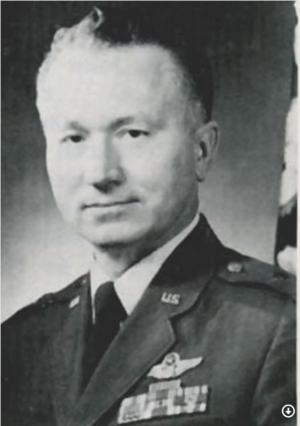Benton K. Partin
(officer) | |
|---|---|
 | |
| Born | 2 December 1925 |
| Died | 20 December 2019 (Age 94) |
| Nationality | US |
| Alma mater | Air Force Institute of Technology, Air War College, Case Institute of Technology, Western Reserve University |
| Exposed | Oklahoma City bombing |
Brigadier General Partin had over 25 years experience in explosives and ballistic weapons design and testing for the US Air Force. He was highly critical of the US government's official narrative about the Oklahoma City bombing | |
Brigadier General Benton K. Partin had over 25 years experience in explosives and ballistic weapons design and testing for the US Air Force.[1]
Partin was highly critical of the US government's official narrative about the Oklahoma City bombing.[2]. When, on 19 April 1995, the Alfred Murrah Federal Building in Oklahoma City, collapsed, killing 168 people, General Partin immediately declared: Someone is lying! As one of America’s foremost weapons experts, Partin could immediately see that the damage pattern on the building was not consistent with a truck bomb on the road, but could have only been the result of a building demolition team imbedding explosives in the actual reinforced concrete pillars holding up the building.[3]
Career
Partin was born in Lumberton, North Carolina. He entered active military service in the aviation cadet program in January 1944. He reentered active military duty in August 1949 with an assignment in the Strategic Air Command as assistant operations officer. In September 1953 Partin entered the Air Force Institute of Technology in the first two-year Graduate Air Ordnance Program, where he received a master of science degree in aeronautical engineering in 1955. In September 1955 he was assigned to the Ballistics Research Laboratories, Aberdeen Proving Grounds, Maryland. There, as an interservice exchange project engineer, he worked on a variety of armament projects; primarily on warhead and fuse developments for both Air Force and Army missiles.[4]
In July 1957 General Partin was assigned to the Air Weapons Directorate, Headquarters Air Research and Development Command. He later moved with the command headquarters to Andrews Air Force Base, where he was the assistant for advanced weapons concepts.[4]
In January 1969 Partin was assigned special duty in the Office of the Secretary of Defense as the first Chairman of the Department of Defense Air Munition Requirements and Development Committee.[4]
Partin was transferred to Eglin Air Force Base in June 1970, where he was commander of the Air Force Armament Laboratory.[4] He retired in 1978 as a U.S. Air Force Brigadier General.[5]
Oklahoma City bombing
- Full article: Oklahoma City bombing
- Full article: Oklahoma City bombing
"When I first saw the pictures of the truck-bomb's asymmetrical damage to the Federal Building, my immediate reaction was that the pattern of damage would have been technically impossible without supplementing demolition charges at some of the reinforcing concrete column bases... For a simplistic blast truck-bomb, of the size and composition reported, to be able to reach out on the order of 60 feet and collapse a reinforced column base the size of column A-7 is beyond credulity."
General Partin further explained that:
"The total incompatibility with a single truck bomb lies in the fact that either some columns collapsed that should not have collapsed or some of the columns are still standing that should of collapsed and did not."
"Reinforced concrete targets in large buildings are hard targets to blast. I know of no way possible to reproduce the apparent building damage through simply a truck bomb effort."
"It is easy to determine whether a column was failed by contact demolition charges or by blast loading (such as a truck bomb)," Partin wrote in his letter to Congress.
"It is also easy to cover up crucial evidence as was apparently done in Waco. I understand that the building is to be demolished by May 23rd or 24th. Why the rush to destroy the evidence?"
He concluded:
"This is a massive cover-up of immense proportions."[6]
TWA 800
- Full article: TWA 800
- Full article: TWA 800
Partin also contributed to analysis of flight TWA 800. He indicated that the evidence gathered from the 1996 crash of the airplane outside Long Island, New York, was most consistent with the patterns of damage that would have been caused by an explosion near the Boeing 747 of a radio-guided continuous-rod warhead, in other words, a missile.[7]
References
- ↑ https://www.hmsschoolofchristianjournalism.org/general-partin-articles-storage/tribute-to-brigadier-general-benton-kirk-partin
- ↑ http://www.bibliotecapleyades.net/sociopolitica/sociopol_waronterror27.htm
- ↑ https://www.hmsschoolofchristianjournalism.org/general-partin-articles-storage/tribute-to-brigadier-general-benton-kirk-partin
- ↑ Jump up to: a b c d https://www.af.mil/About-Us/Biographies/Display/Article/106051/brigadier-general-benton-k-partin/
- ↑ https://valor.militarytimes.com/hero/391814
- ↑ Document:Systemic Destabilization in Recent American History
- ↑ http://www.padrak.com/alt/TWA800CDA.html